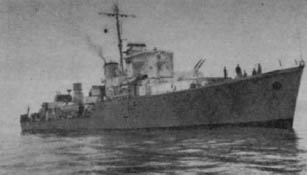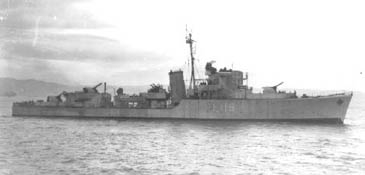|
HMS Silverton was launched on 5.XII.1939, and loaned to the Polish Navy on 28.V.1941 and returned to the Royal Navy on 28.IX.1946. First commander of the ship was lt. cmdr. Tadeusz Gorazdowski. After monthly drills Krakowiak joined 15 Destroyer Flotilla. And until the December the ship was escorting convoys in the English Channel.
In December 1941 she took part in action against Lofoten (Operation "Anklet"). The purpose of the operation was to destroy the German base and installations on the Lofoten Islands. After a successful beginning the destruction of the German base, allied ships were forced by the German Luftwaffe to leave Lofoten, and on 1.I.1942 ships returned to the Scapa Flow. From January to the end of February Krakowiak escorted coastal convoys. On 15.V.1942 Krakowiak with the British destroyer Tynedale and Dutch MTBs attacked a German convoy near Cap de La Hauge, consisting of one transporter and enemy minesweeper. Probably both vassels were only damaged.
 | | Krakowiak in 1942 |
On 13.VI.1942 Krakowiak shot down an enemy bomber. On 1.X.1942 the convoy that Krakowiak was escorting was attacked by German Schnellboats S 8, S 65, S 77 and S 112. Two boats were damaged by Krakowiak gunfire. On 14.X.1942 Krakowiak with other British destroyers was covering British and Dutch MTBs that attacked and sunk German Auxiliary cruiser Komet. On 2.XI.1942 Krakowiak, British Tynedale and MTB attacked a German convoy, comprising of 3 troop ships and 4 patrol boats. One enemy troop ship and one patrol boat were sunk by MTBs. On 16.XI.1942 Krakowiak with Slazak was searching for British pilots. At the end of 1942 Krakowiak was in dry dock for repairs until end of January 1943.
On 4.II.1943 Krakowiak sunk with another British destroyer two ships. At the beginning of February Krakowiak was escorting a convoy to the Mediterranean, and returned to the British Isles at the beginning of March. On 3.III.1943 Krakowiak fought in the English Channel with German Schnellboats, during which probably S 70 (but this is unconfirmed) was sunk by the Polish destroyer. At the beginning of March the ship was sent again with a convoy to the Mediterranean. Krakowiak returned to England in the middle of April for renovation after which she was moved to the Mediterranean.
During this time Krakowiak was escorting convoys to Sicily, Haifa (from July to middle of August). At the end of August Krakowiak took part in landing near Salerno as a part of "V" team (5 escort carriers, 2 cruisers, 8 escort destroyers). In September 1943 Krakowiak was escorting carriers from "V" team (and on 1.IX.1943 found two or possibly three high-ranking British pilots in a dinghy near Crete, who had been shot down. In October she was moved to Beirut, from which Krakowiak was patrolling area of Aegean Sea. On 1.XI.1943 Krakowiak with British destroyers shelled German port in Kalymnos. Nine days later on 10.XI.1943 Krakowiak with British destroyers Petard and Rockwood again shelled Kalymnos, but this time one Italian troop Trapani (1885 BRT) was sunk. During November Krakowiak was firing German positions in Aegean Islands and patrolling those areas. At the beginning of January 1944 Krakowiak escorted Polish army (II Corpus) to Taranto, Southern Italy, during this time firing at enemy planes. At the end of January 1944 Krakowiak was moved to Naples, from which she was moved in February to Alexandria. On 8.IV.1944 Krakowiak departed the Mediterranean and on 17.IV.1944 arrived at Plymouth.
Until the end of May the ship was undergoing repairs and afterwards Krakowiak took part in drills before "D-Day".
 | | Krakowiak's crew with booted German flag |
During the Normandy invasion Krakowiak fired at German coastal positions at the port of Trouville where three German escort ships were anchored behind a breakwater, which protected all but the topmost parts of the ships. It was thought that some of the crew had already abandoned the ships and during the night a group of approximately a dozen armed sailors from Krakowiak were sent in a motorboat on a surprise reconnaissance mission to these ships. On reaching and boarding the first of the ships, the Germans began to flee from one ship to the next and then to the third, leaving their dead and wounded behind, running along the breakwater to join other German troops on shore. The mission returned safely on board Krakowiak but within an hour the ship was lit up by flare bombs and bombed by a German plane, which thanks to heavy firing by Krakowiak did not succeed in hitting the ship.
Five days later on 11.VI.1944 she sunk with Canadian destroyers Gatineau, Sioux and British frigate Duff two enemy Schnellboats S 136 and S 137 (according to latest sources - E.Gröner "Die deutschen Kriegsschiffe 1815-1945"; Bonn 1999 - S 137 was sunk by British aircraft on 29.VII.43). Until 16.VII.1944 Krakowiak was patrolling areas near landing areas. In November the ship underwent renovation until 3.III.1945. On 26.III.1945 Krakowiak damaged enemy Schnellboat. This was the last action of the Polish ship in World War II.
 | | Krakowiak in the end of the war in 1945 |
On 25.V.1945 with Slazak she sailed to Wilhelmshaven, after whhich Krakowiak escorted coastal convoys. In December 1945 she took part in "Operation Deadlight", when on 28.XI.1945 Krakowiak sunk U 2337, and in 1946, when on 31.XII.1946 Krakowiak sunk U 1165, which was an operation of the sinking of several German U-boats near Iceland. In July 1946 Krakowiak was moved to reserve and on 28.IX.1946 was returned to the Royal Navy. In March 1947 the Polish Sea Mission proposed to the British the exchange of old and used Burza and Wilk for two Hunts, but the British Admiralty for obvious reasons refused this. Silverton stayed in reserve for another 13 years until 1952 when she was used as frigate (tactical number F 55). On 11.III.1958 Silverton was sold for scrapping.
|